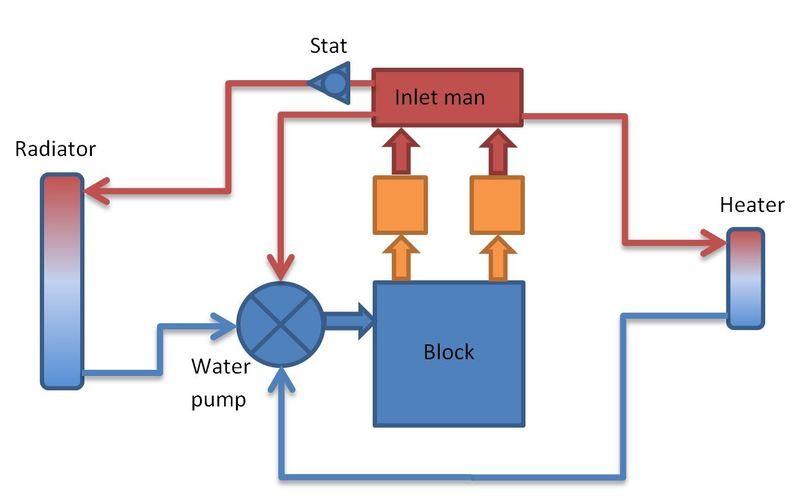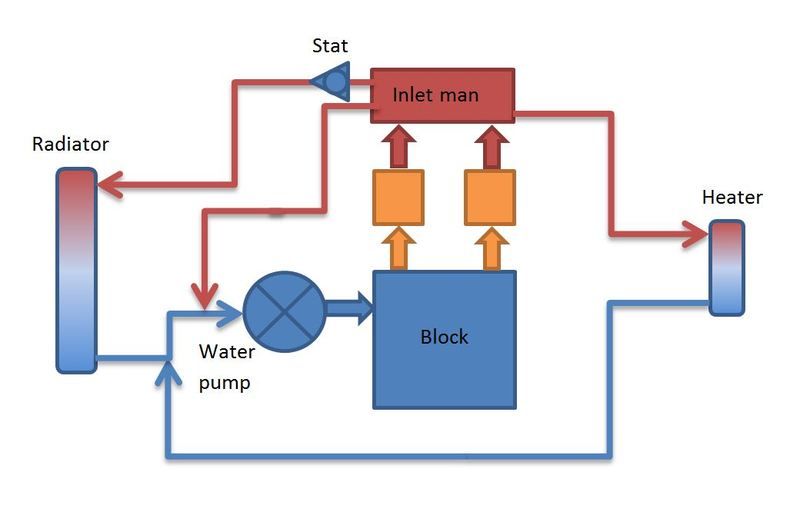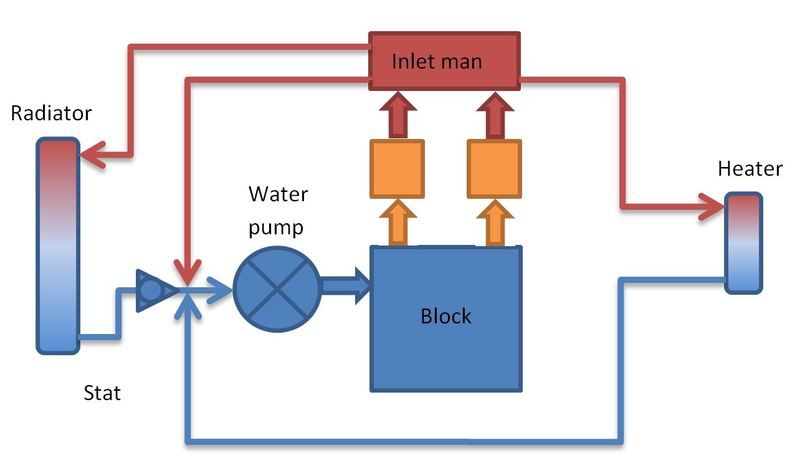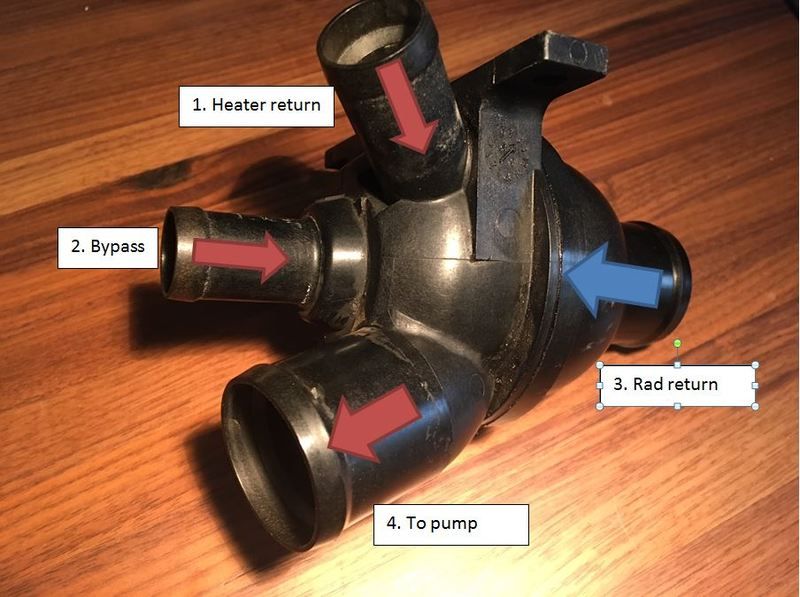Page 1 of 1
Coolant plumbing options
Posted: Thu Jul 21, 2016 6:24 pm
by benjai
Quick question for you V8 folks – I have a 4.6 RV8 with an interim front end and Edelbrock intake and carb. I’ve figured out how the bypass cooling flow works in the Range Rover and I’m wondering about the best way to achieve this in the car. The summary is – do I need a dedicated bypass or will the flow thorugh the heater be sufficient (and in this case, I assume a small drilling in the stat to ensure it sees some hot coolant is a good idea). Alternatively, should I ditch the stat in the inlet manifold and instead use the Range Rover remote stat housing in the bottom hose. One disadvantage I can see to this is the inability to change the stat temp? Any thoughts or personal expeiences will be gratefully received.
To expand a bit, here’s the exisiting set-up on the non-serp 3.5 RV8 that is currently installed – Thermostat in top hose with bypass. When closed, coolant returns through both the heater and the bypass hose. When thermostat open, coolant flows through all three circuits (two above plus rad), since I can’t see any provision for the bypass closing when the thermostat opens.

Option 1 : Thermostat in top hose. Permanent bypass provided by heater circuit. No other bypass.

Option 2: As suggestion 1 but with additional bypass hose.

Option 3: As per RR set-up. Thermostat in bottom hose. Top hose straight from inlet to rad. Bypass hose and heater return hoses feed into thermostat housing on outlet side. When cold, thermostat is closed and heater and bypass hoses carry coolant back to the thermostat housing and then to the pump. When the thermostat opens, water flow through the rad is allowed and the thermostat also block off the bypass hose inside the thermostat housing.

Here’s what the thermostat housing looks like (in case you are not familiar with it). The stat blocks the rad hose when cold, and the bypass when hot.

So the question is – do I just go with the only bypass through the heater (option 1) and keep the tried and tested stat in the top hose arrangement, or go all Range Rovery and use the remote stat as per option 3?
Posted: Fri Jul 22, 2016 7:30 am
by SuperV8
My system looks like your option three drawing using a remote thermostat. There are other temp versions of remote thermostats available used on other Landrover/MG's I'm using the 82deg one which seems to keep my engine at between 85 and 90, although creeps up to 95-100 in traffic but I suspect that's just down to limited size rad but lately i've been thinking of restricting my heater circuit to see if this helps on hot days.
http://wiki.seloc.org/a/Pressure_Relief ... Thermostat
I would say you don't need both a bypass and a heater circuit when using a traditional thermostat location as long as your heater circuit is not valved off.
Tom.
Posted: Fri Jul 22, 2016 8:20 am
by garrycol
If I can - a side but related question? How is important is it to have a bypass?
I am putting together a serpentine Thor 4.6 but am using a modified 3.5 thermostat housing on the Thor manifold - as such it does not have the 4.6 thermostat pictured above nor the s pipe linking the inlet manifold to the rear of the water pump as the 3.5s have. I guess I could rig up a small coolant return in the system but would prefer not do unless absolutely needed.
So as not to divert the tread too much just a short yes/no type answers appreciated.
Thanks
Garry
Posted: Fri Jul 22, 2016 10:28 am
by SuperV8
When the thermostat is closed you still need a flow of coolant around the engine so you need either a bypass circuit and/or a heater circuit (which also acts as a bypass as long as it can't be shut off).
The GEMS inlet manifold has a heater take off which could work as your bypass.
Tom.
Posted: Fri Jul 22, 2016 3:03 pm
by garrycol
Ok thanks - not a Gems and the heater has to be shut off. I will need to rig something up then.
Cheers
Garry
Posted: Sat Jul 23, 2016 9:51 am
by benjai
SuperV8 wrote:My system looks like your option three drawing using a remote thermostat. There are other temp versions of remote thermostats available used on other Landrover/MG's I'm using the 82deg one which seems to keep my engine at between 85 and 90, although creeps up to 95-100 in traffic but I suspect that's just down to limited size rad but lately i've been thinking of restricting my heater circuit to see if this helps on hot days.
http://wiki.seloc.org/a/Pressure_Relief ... Thermostat
I would say you don't need both a bypass and a heater circuit when using a traditional thermostat location as long as your heater circuit is not valved off.
Tom.
Tom,
Thanks a lot. That's basically what I figured, but it's good to know I'm not insane... I guess I can set it up using just the heater as a bypass, and if I see any issues (though I can't really think what they would be, except a very slightly higher backpressure in the cooling circuit) I can add a bypass. As I have the stat housing with the bypass outlet, I can do this easily from the front of the manifold, while connecting the heater at the rear.
I think I'll also drill a small (4mm or so ) hole in the thermostat so that it does see some hot coolant even when it's "closed". Otherwise I suppose it could remain cooler than the engine because the hot coolant from the heads will exit to the heater through the rear outlet (which is nowhere near the thermostat).
Also, I did not know about the availabilty of different temperature remote themostats - thanks a lot for the link.
Ben
Posted: Tue Jul 26, 2016 8:11 am
by SuperV8
Ben,
If using the remote thermostat you still need a bypass to the thermostat so it can sense engine coolant temp.
The one of the benefits of the remote thermostat is that it can block off this bypass so all coolant goes through the rad. (except the heater circuit!, which i'm going to restrict/remove)
Tom.
Posted: Tue Jul 26, 2016 5:21 pm
by benjai
Tom,
Thanks - got it... Sorry I wasn't clear. I'm going to start off with the conventional stat in the inlet manifold setup, and provide bypass via the heater from the rear of the manifold returning to the bottom hose/pump inlet. I realised when I re-read my post, I'd not made the destinction that the remote thermostat will be the backup option. The comment about drilling a hole in the stat to allow a small amount of flow similarly applies to the "stat in the inlet manifold" setup.
OOps, just re-read your post... I think you are also saying that with the remote thermostat you still need a bypass too. I suppose this is because if the "heater" is doing it's job, then it will be cooling the coolant and the remote thermostat won't see the water temperature that's actually coming out of the engine... I'll bear that in mind if do switch to the remote setup.
Who'd have though plumbing could be this complex... And I've not even mentioned expansion tanks, header tanks or breathers yet...!
Thanks again,
Ben
Posted: Wed Jul 27, 2016 10:30 pm
by Denis247
I use your option 2, using a Rover P5B thermostat housing on an Offenhauser manifold.
My (82') thermostat has a small breather hole as standard, which is positioned at the top, but I also have drilled 3 x 1/8" holes in it.
My header tank feeds the bottom hose as standard, and also has a small 1/4" ish breather/bleed hose into the highest point of the top hose. This is also making a bit of a radiator bypass circuit, making 3 in total (incl heater circuit), but remember although the hose from the thermostat housing to the front cover is 1/2" it feeds into the pump via a small 1/4" ish hole in the cover.
I run Valvoline VR1 mineral oil (always used to use fully synthetic) and Bluecol anti-freeze and have 2 x 12" puller fans controlled by a 2-stage thermostat.
So far it all seems ok









